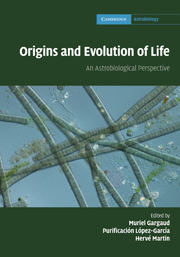Book contents
- Frontmatter
- Contents
- List of contributors
- Foreword
- Preface
- Part I What is life?
- Part II Astronomical and geophysical context of the emergence of life
- Part III The role of water in the emergence of life
- Part IV From non-living systems to life
- Part V Mechanisms for life evolution
- 19 Molecular phylogeny: inferring the patterns of evolution
- 20 Horizontal gene transfer: mechanisms and evolutionary consequences
- 21 The role of symbiosis in eukaryotic evolution
- Part VI Life in extreme conditions
- Part VII Traces of life and biosignatures
- Part VIII Life elsewhere?
- Index
19 - Molecular phylogeny: inferring the patterns of evolution
from Part V - Mechanisms for life evolution
Published online by Cambridge University Press: 04 February 2011
- Frontmatter
- Contents
- List of contributors
- Foreword
- Preface
- Part I What is life?
- Part II Astronomical and geophysical context of the emergence of life
- Part III The role of water in the emergence of life
- Part IV From non-living systems to life
- Part V Mechanisms for life evolution
- 19 Molecular phylogeny: inferring the patterns of evolution
- 20 Horizontal gene transfer: mechanisms and evolutionary consequences
- 21 The role of symbiosis in eukaryotic evolution
- Part VI Life in extreme conditions
- Part VII Traces of life and biosignatures
- Part VIII Life elsewhere?
- Index
Summary
Preamble: the vertical inheritance of genetic material
Living systems are ephemeral vehicles of their immortal germlines. In the selfish-gene (Dawkins, 1976) or disposable-soma (Kirkwood, 1977) perspectives, genes do have a greater interest in regularly ‘buying a new vehicle and throwing away the old one’. Rather than being forever stuck in the same organism genes can reassort themselves with random samples of the genetic-material pool through sexual reproduction. As human beings we are thus familiar with the widespread biparental reproduction procedure. Two individuals – the parents – spawn reproductive cells – the gametes – which merge to produce offspring – the descendants. In diploid populations, each descendant receives a paternal copy and a maternal copy of the genome (Figure 19.1). Because of the recombination occurring in the germline each parental copy is itself a reassortment of the grandmaternal and grandpaternal genomes. From generation to generation gene copies are replicated. If they are transmitted to at least two descendants (Figure 19.1: stars), this will result in branching nodes in what we call ‘gene trees’ (Maddison, 1997).
This transmission of the genetic material is called ‘vertical’: DNA of an organism is inherited from its forebears. Vertical gene transfer implies that there is a tree structure describing the history of descent of the genetic material. By contrast, there is horizontal gene transfer when genetic material is passed on from donor organisms to receptors belonging to different species (see Chapter 20).
Information
- Type
- Chapter
- Information
- Origins and Evolution of LifeAn Astrobiological Perspective, pp. 291 - 312Publisher: Cambridge University PressPrint publication year: 2011
Accessibility standard: Unknown
Why this information is here
This section outlines the accessibility features of this content - including support for screen readers, full keyboard navigation and high-contrast display options. This may not be relevant for you.Accessibility Information
- 1
- Cited by
